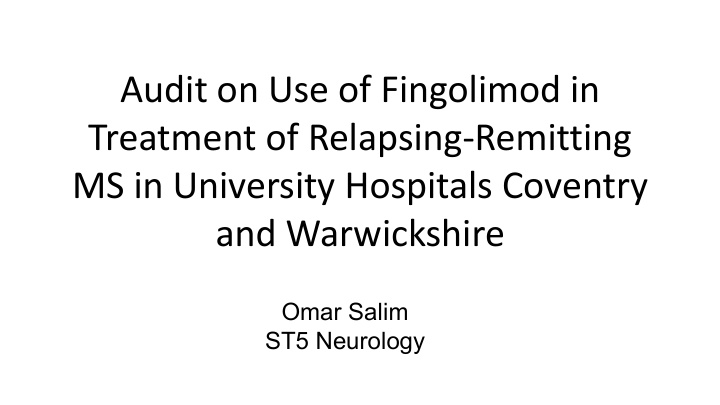



Audit on Use of Fingolimod in Treatment of Relapsing-Remitting MS in University Hospitals Coventry and Warwickshire Omar Salim ST5 Neurology
Aims § To assess the ‘real world’ experience of Fingolimod use in University Hospitals Coventry and Warwickshire – a terBary centre for MS § To assess compliance with naBonal guidelines § To assess safety and efficacy
Standards NICE [TA254] April 2012 - Fingolimod for the treatment of highly active relapsing–remitting multiple sclerosis “Treatment of highly active relapsing-remitting multiple sclerosis in patients who have high disease activity despite treatment with at least one disease modifying therapy or in those initiated under specialist supervision)”
NICE Guidelines on Fingolimod Treatment of highly active relapsing-remitting multiple sclerosis in patients who have high disease activity despite treatment with at least one disease modifying therapy or in those with rapidly evolving severe relapsing-remitting multiple sclerosis (initiated under specialist supervision)
Methods § Using electronic patient records, patients were identified § Inclusion criteria: Diagnosis of Relapse-Remitting MS § Duration of Fingolimod treatment of at least 12 months § Treatment starting between March 2013 – July 2017 § 107 patients were identified, 82 of them had Fingolimod for at least 12 months
Data Collected Demographics Monitoring on Fingolimod § § Gender § § Age at diagnosis of RRMS Macular oedema monitoring § at 3 -4 months § Pre-Fingolimod § Pre Initiation if history of Diabetes or § Previous DMT § Uveitis § Reason for star?ng Fingolimod First dose cardiac monitoring § ALT checked every 6 months and if § Fingolimod § evidence of derangement § Date started Timing of MRI monitoring of disease § Age at commencement § activity Date stopped § EDSS pre and during treatment § § EDSS pre and during treatment Lowest lymphocytes count § Action taken if pregnancy during therapy § § Post-Fingolimod § Reason for stopping Treatment changed to § § Escala?on/De-escala?on of treatment
Fingolimod commencement 35 30 Number of patients 25 20 M 15 F 10 5 0 2013 2014 2015 2016 2017 2018
A total of 107 patients with MS have been prescribed Fingolimod at UHCW 82 of 107 have taken Fingolimod for at least 12 months (range 12- 63 months) Average use is 32 months 70 60 Number of months 50 40 30 20 10 0 0 10 20 30 40 50 60 70 80 90 Number of patients
Demographics Gender Male 28% Female 72%
Age distribution Age at diagnosis 70 Dx of RRMS 60 50 Range: 14- 58 40 Average: 33 30 20 10 0 0 20 40 60 80 100 120 Age at commencement Age at commencement of 70 Fingolimod 60 Range: 16- 61 50 40 Average: 40.7 30 20 10 0 0 20 40 60 80 100 120
Previous DMTs prior to Fingolimod Tysabri Rebif Copaxone Aubagio Avonex Betaferon Tecfidera Plegridy 2% 11% 19% 10% 17% 25% 11% 5%
17 Patients on other Oral DMTS were switched to Fingolimod 14 12 10 8 6 4 2 0 Tecfidera Aubagio Relapsed on fingolimod
Treatment status of All Fingolimod Patients Ongoing Stopped unknown 1% 27% 72%
70 patients were changed to Fingolimod from Injectable DMTs 60 50 40 30 20 10 0 Ongoing stopped
18 patients were changed to the treatment below Cladrabine Aubagio 5% 6% N/A 6% Lemtrada 33% Tyasbri 11% Tecfidera 11% Cladrabine 1 Aubagio 1 none N/A 1 Tyasbri 2 28% Tecfidera 2 none 5 Lemtrada 6
Reason for switching to Fingolimod Relapse 70 High Risk of PML 18 Disease Activity on MRI 13 side effects 4 patient choice 1 Allergic reaction 1 0 10 20 30 40 50 60 70 80 Number of patients Patient choice and Allergy reasons were initially Tysabri patients
20 Pa&ents were switched from Natalizumab to Fingolimod Reason for switching 20 18 16 14 12 10 8 6 4 2 0 Physician advice Pt choice feared risk (High risk of PML) of PML)
Current status of those 20 Patients whom were switched from Natalizumab to Fingolimod Cladrabine No Rx 5% 10% Continued Lemtrada 35% 30% Continued but relpased 20%
Fingolimod was stopped/changed in 28 out of 107 patients Reasons for cessation Relapse S/E Lymphopenia MRI Disease activity Disease progression Deranged LFTs Allergic reaction Non-compliance Deteriorating vision Macular oedema 0 2 4 6 8 10 12 14 Percentage of patients (%)
Relapses on Fingolimod 27 pa1ents had relapses • 14 out of 27 con1nued on Fingolimod • 3 went on to Natalizumab • 11% 10 switched to Alemtuzumab • Fingolimod continued Lemtrada 52% 37% Tysabri
Treatment post-Fingolimod Aubagio Tysabri Tecfidera Cladrabine None Lemtrada 0 5 10 15 Percentage of patients (%)
Macular oedema screening with OCT at 3-4 months from initiating Fingolimod 3% Performed 45% 52% Delayed N/A 97% had Macular Oedema screening, 52% within recommended timescale
ALT check every 6/12 2% 18% 4% 78% 2% Yes Delayed Rx ceased early 9 months
Lymphocyte count 2.50 2.00 Lymphocyte count 1.50 1.00 0.50 0.00 0 20 40 60 80 100 120 Number of patients Average lymphocyte count from 107 patients received Fingolimod was 0.26
Monitoring with MRI : Duration post- Fingolimod initiation 70 60 50 Number of patients 40 30 20 10 0 <12 months 12-15 months >15 months Since 2016, patients have repeat scan within 12 months and annually thereafter
Conclusions Compliance with prescribing § -100% compliance with indications as per NICE Adverse events § Generally well tolerated – All patients tolerated 1 st dose – Monitoring § One patient was identified with MO and Fingolimod was stopped (screening done at 5 months) – – Macular oedema screening identified as requiring improvement Improvements identified since 2016 in MRI monitoring at 12 months but needs more! – Clinical effectiveness § Data suggests fewer rates of relapse and therefore effective as a second line DMT – – Those who were changed from Tysabri to Fingolimod benefited less well compared to other DMTs
• Thanks for listening! • ? Questions
Recommend
More recommend